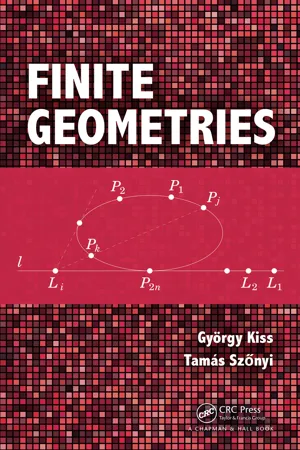
This is a test
- 338 pages
- English
- ePUB (mobile friendly)
- Available on iOS & Android
eBook - ePub
Finite Geometries
Book details
Book preview
Table of contents
Citations
About This Book
Finite Geometries stands out from recent textbooks about the subject of finite geometries by having a broader scope. The authors thoroughly explain how the subject of finite geometries is a central part of discrete mathematics. The text is suitable for undergraduate and graduate courses. Additionally, it can be used as reference material on recent works.
The authors examine how finite geometries' applicable nature led to solutions of open problems in different fields, such as design theory, cryptography and extremal combinatorics. Other areas covered include proof techniques using polynomials in case of Desarguesian planes, and applications in extremal combinatorics, plus, recent material and developments.
Features:
-
- Includes exercise sets for possible use in a graduate course
-
- Discusses applications to graph theory and extremal combinatorics
-
- Covers coding theory and cryptography
-
- Translated and revised text from the Hungarian published version
Frequently asked questions
At the moment all of our mobile-responsive ePub books are available to download via the app. Most of our PDFs are also available to download and we're working on making the final remaining ones downloadable now. Learn more here.
Both plans give you full access to the library and all of Perlego’s features. The only differences are the price and subscription period: With the annual plan you’ll save around 30% compared to 12 months on the monthly plan.
We are an online textbook subscription service, where you can get access to an entire online library for less than the price of a single book per month. With over 1 million books across 1000+ topics, we’ve got you covered! Learn more here.
Look out for the read-aloud symbol on your next book to see if you can listen to it. The read-aloud tool reads text aloud for you, highlighting the text as it is being read. You can pause it, speed it up and slow it down. Learn more here.
Yes, you can access Finite Geometries by Gyorgy Kiss, Tamas Szonyi in PDF and/or ePUB format, as well as other popular books in Mathematics & Mathematics General. We have over one million books available in our catalogue for you to explore.
Information
1
Definition of projective planes, examples
In this book some familiarity with classical geometry will be assumed. The classical results will not be used explicitly, but will just provide some background motivation for some of the results. Probably everyone has learnt about Euclidean planes. The classical projective plane comes from the classical Euclidean plane by introducing ideal (or infinite) elements. Associated to a parallel class of lines we have an ideal (or infinite) point, and the ideal line (or line at infinity) consists of all the infinite points. The advantage of introducing the classical projective plane is that there is no difference between ordinary and ideal points; two lines always intersect. In classical geometry typical theorems state that under some conditions certain lines pass through a point (for example, if we take a triangle, then the angle bisectors pass through a point) or certain points are on a line. In some cases, the classical theorems use metric properties of the plane (distances and angles), in other cases the order of the points on a line, but there are interesting results that just use incidences of points and lines. A notable example for this is the celebrated Theorem of Desargues.
Theorem 1.1. Let A1A2A3 and B1B2B3 be two triangles in such a position that the lines AiBi pass through a point O. Consider the points , where {i, j, k} = {1, 2, 3}. Then the points C1, C2, C3 are on a line t.
Less formally, when the two triangles are in perspective from the point O then they are also in perspective from the line t. More details on Desargues’ theorem can be found in Coxeter’s book [48], where similar theorems, for example the Theorem of Pappus, are also discussed. These theorems will also occur in our book, mainly in the context of finite planes and spaces. In Chapters 2 and 3 we shall see how particular cases of Desargues’ theorem are related to properties of the coordinate structure of the projective plane. We shall also call the configuration of the ten points (A’s, B’s and C’s and O) and the ten lines (the lines AiBi, the sides of the two triangles and the line t) a closed Desargues configura...
Table of contents
- Cover
- Half Title
- Title Page
- Copyright Page
- Contents
- Preface
- 1. Definition of projective planes, examples
- 2. Basic properties of collineations and the Theorem of Baer
- 3. Coordinatization of projective planes
- 4. Projective spaces of higher dimensions
- 5. Higher dimensional representations
- 6. Arcs, ovals and blocking sets
- 7. (k; n)-arcs and multiple blocking sets
- 8. Algebraic curves and finite geometry
- 9. Arcs, caps, unitals and blocking sets in higher dimensional spaces
- 10. Generalized polygons, Möbius planes
- 11. Hyperovals
- 12. Some applications of finite geometry in combinatorics
- 13. Some applications of finite geometry in coding theory and cryptography
- Bibliography
- Index